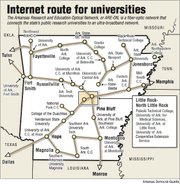After three hours of debate that several legislators called troubling and frustrating, a meeting of legislative technology and education committees ended Wednesday without recommendations for increasing broadband Internet access for school districts.
Instead, members of the Joint Advanced Communications and Technology Committee and the House and Senate Education committees asked for consensus on basic information.
"It just defies logic to me that it would take more than two or three days to get the information we want to answer these questions," said Sen. Joyce Elliott, D-Little Rock. "How much [bandwidth] is available and how much do we need? To me that's like addition and subtraction. This just has to be available somewhere ... end of story."
The meeting was held to discuss how or even whether to require school districts to meet a national standard for broadband bandwidth, and it followed the release of the Quality Digital Learning Study last month.
A lack of bandwidth is starting to cause problems for schools as more standardized tests move to online formats, including the STAR reading-assessment exam that will be administered entirely online in the 2014-15 school year. Act 1280 of 2013 also requires every school to provide at least one interactive online course beginning this fall.
Internet broadband access becomes an issue of equity between rural and urban districts because access is often more elusive and more expensive for rural districts limited by geography and by smaller class sizes that also bring smaller budgets.
Ed Franklin, chairman of the Quality Digital Learning Study Committee, repeated recommendations from the group's year-long study that the state run a centralized broadband network, require districts to meet 2015 and 2018 national industry standards for bandwidth and amend a state law to allow schools for kindergarten through the 12th grade to access existing, privately owned fiber-optic cable structures used by the state's universities and teaching hospitals.
The study, requested by the Legislature, which appointed the committee, was released in April.
Legislators spent hours asking both Franklin and private telecommunications providers to explain what infrastructure was available for school districts on both the private networks and on the Arkansas Research and Education Optical Network -- a public-private system of cable that connects universities, community colleges, teaching hospitals and university libraries.
A survey of school districts by the Arkansas Department of Education late last year showed some districts had as little as 3 kilobits per second per student of bandwidth while others had more than 800 kilobits per student. The industry standard recommended for 2015 is 100 kilobits per second per student, according to the study.
Legislators also asked why the cost varied drastically between school districts to purchase appropriate bandwidth capability.
The digital-learning study showed some schools paying as low as $1.20 per megabit (roughly 1,000 kilobits per second) of capacity while elsewhere the price was $280 per megabit of capacity. The larger the capacity, the more students can use the Internet at the same time and the faster the information travels.
The private providers and Franklin argued about all aspects of the legislators' questions. Franklin said the private companies had not been forthcoming concerning what infrastructure exists and what it would cost to lay cables to the remaining underserved schools.
Jordan Johnson, the spokesman for the providers united under the name Arkansas Broadband Coalition for Kids, said the providers had signed nondisclosure agreements with the state but provided the information in the appropriate format to a liaison at the governor's office.
He and other group members also said the state Department of Education and the study committee would not provide them with a list of schools lacking adequate access to broadband.
Johnson contended that the survey results in the study, which reported 80 percent of superintendents saying they have inadequate broadband access, were misconstrued. He said those districts were reporting what they had purchased, not what private providers could offer with existing infrastructure.
The back-and-forth confounded a handful of legislators.
"There ought to be specific specs set up to service these schools ... so that people know how to build this system moving forward, because it's been rather haphazard," said Sen. Linda Chesterfield, D-Little Rock. "If we're going to move forward once again, we've got to all come to the table, in my view. Let's talk about what we can do collectively. If there are things we need to do individually, let's do that. ... Kids are losing out, and we need to stop talking about this is mine, this is mine. We need to talk about ours."
The conversation returned repeatedly to whether to allow K-12 schools to connect to the universities' ARE-ON network. Act 1050 of 2011 specifically prohibits the network from being used to provide connectivity to school districts.
Johnson said those restrictions were put in place to prevent the state from competing with private Internet providers.
"In essence that would be taking away our customers and selling them back to us because we own the cable [in the ARE-ON network]," said Len Pitcock, chairman of the Arkansas Cable Telecommunications Association and director of governmental affairs for Cox Communications.
Chesterfield argued that if a private service provider did not want to extend service into an area because it wouldn't yield enough profit -- for example the McAlmont neighborhood of North Little Rock, she said -- then the state should be allowed to connect schools to the ARE-ON infrastructure.
Private service providers argued that the state would lose money by doing that because individual districts can apply for reimbursement of up to 90 percent to pay for the infrastructure needed to supply broadband under the federal e-rate program. The state cannot apply for the same reimbursements, they said.
The House and Senate Education committees will continue to look at broadband access as part of the biannual educational-adequacy study, which requires that recommendations be made to the full Legislature by Nov. 1.
Metro on 05/29/2014
